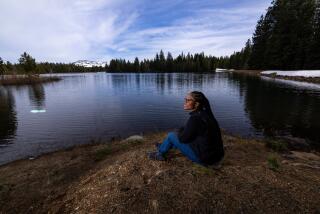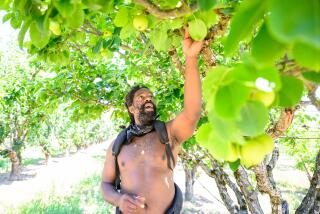Historic Black Farm Colony Is One Gust Away From Oblivion
- Share via
DEARFIELD, Colo. — This dry, lousy prairie is the last place Walker Groves expected to see again.
Once it was advertised as a free Eden for poor city blacks. But that was six decades ago, before this place killed Groves’ father. Before Groves, still in his teens, turned his back on sod-busting and retraced the three-hour trip to Denver, relieved to be riding the streetcar instead of a horse.
Christened Dearfield by optimistic homesteaders, one of the West’s more spirited and prosperous utopian experiments is a shriveled husk now.
Only four structures remain, one gust away from oblivion: two shacks, the luncheonette and a shed.
The ceaseless wind has desiccated the plank walls into brittle wood jerky. A sour whiff of distant cattle feedlots and hog farms seeps through broken windows.
Hay trucks barreling down the two-lane blacktop are 18-wheel earthquakes, shivering the ruins and flushing a great horned owl from its fence-post perch. At least it’s bitterly cold now. In July, the place crawls with bull snakes and buzzes with locusts.
But a few years ago, Walker Groves, now 73, returned to live here in the echo of his childhood.
He raises goats, chickens and the occasional steer on a 160-acre spread just a few miles east of the same sagebrush and buffalo grass that his father couldn’t tame. A garrulous man with creaseless features and coal-black hair, he greets the irony with a booming laugh.
Just don’t call him a farmer.
“I call myself a cowboy,” Groves nearly shouts from the living room of his brick-and-block house.
His wife and a grown daughter have cranked up the volume on the big-screen TV, keener on a bidding frenzy over a washer-dryer on “The Price Is Right” than on hearing about Dearfield--again.
“I’m not a farmer,” Groves declares. “I have no plans to be one.”
Neither did hundreds of other black men and women who moved here during the first half of the 20th century. That is, until they heard the sales pitch of Oliver T. Jackson.
Jackson was a disciple of Booker T. Washington, founder of the Tuskegee Institute, the model vocational and teachers school for blacks in Alabama.
Born a slave in Virginia, Washington published newspapers and founded the National Negro Business League to spread his message of wealth and racial self-determination through hard work and property acquisition.
Black farming colonies sprouted throughout the nation after the Civil War, populated by emancipated urban laborers and rural sharecroppers. Princeton historian Nell Painter calls the migrants “exodusters” for their near-Biblical pursuit of personal security and dignity on what too often turned out to be meager land.
Painter’s work is part of a growing body of scholarship and literature on black American history, especially in the West. Pulitzer Prize winner Toni Morrison’s most recent novel, “Paradise,” is centered in an all-black township called Ruby.
In 1992, then Joint Chiefs of Staff chairman Gen. Colin Powell dedicated a memorial to the Buffalo Soldiers, the legendary black cavalry that fought 177 Indian battles across the frontier, including the rescue of white troops at the Battle of Beeches Island east of Dearfield.
Many of the most successful black colonies were in the central Plains. Oklahoma had 100, including populations of 5,000 in Bole and Tats. Fewer than half remain today, and most have lost their schools and post offices.
In Colorado, the black colony movement was embraced with missionary zeal by Jackson, a charismatic but struggling farmer and restaurant owner. With the help of Gov. John Shafroth, he obtained a desert claim on 320 acres in Weld County, 65 miles northeast of Denver.
“If a community of representative families can be located in a farming community,” Jackson predicted, “it would lay the foundation for the race.”
In 1910 seven families heeded Jackson’s call to what they thought would be a land of milk and honey. They spent their first winter hunkered in tents and dugout caves with virtually no firewood.
Without water rights for irrigation, they struggled to grow wheat and alfalfa on dry land. What moisture they got usually arrived in a deluge from anvil-shaped thunderheads. Occasionally it was accompanied by a twister.
Against all odds, Dearfield flourished. Jackson’s ledger shows it had a population of 700 in 1921. Land, livestock and four dozen buildings were valued at $950,000.
Jackson ran the luncheonette and the filling station. His wife, Minorca, was the community judge and notary public. They opened a dance hall to attract visitors from Denver.
The settlement’s initial prosperity remains a marvel, and a mystery.
“They weren’t that far from the South Platte River, but there is no evidence of an irrigation ditch,” said Kris Christiansen of Colorado Preservation Inc. “Yet the records show they grew crops like tomatoes,” which need a lot of water.
The good times were brief. The Great Depression and the Dust Bowl wiped out the settlement. Groves’ father, Walker McKinley Groves, a widower, already had abandoned a worn-out wheat farm near Hill City, Kansas, for steady work in Denver as a tradesman.
By the time the elder Groves met Jackson in 1938, Dearfield already was returning to the sand and sage. The colony’s founder, now in his 70s, turned to fruitless promotions, such as renting vacant cabins to duck and geese hunters.
The 30-year-old buildings needed extensive refurbishment, so Jackson wooed the tradesman with free land under big skies.
It was doomed by, of all things, a farming accident.
In 1939 the elder Groves fell between two horses while plowing a field and suffered internal injuries, including a punctured lung. He died of tuberculosis weeks later.
Other schemes fell by the wayside too, including an offer to turn Dearfield into an internment camp for Japanese Americans during World War II. Jackson died in 1948 trying to persuade discharged black GIs to try farm life.
Dearfield has languished ever since.
In 1995 it was added to the National Register of Historic Places. The Black American West Museum in Denver has purchased parts of the settlement, including Jackson’s house, but lacks funds for restoration. It is perennially listed among the state’s most endangered cultural landmarks.
For now it is nominally protected by a road-building crew that has parked a shantytown of campers, trailers and old school buses on the site.
Now the Colorado Legislature is considering whether to authorize $250,000 to establish a park, stabilize the remaining buildings and erect a roadside marker. The bill has bipartisan sponsorship.
“We need to get roofs on the buildings and the windows boarded,” said Christiansen of Colorado Preservation Inc. “The site is begging to be saved.”
Nowadays, Walker Groves would agree. He might even lend a hand.
His father’s death--and his own year behind a plow--had convinced him that country life was a ticket to purgatory, not prosperity.
“The winters were hard, and you had to dig 200 feet for water,” Groves said. “People in Dearfield had no money, no wood for the potbelly stove. They were living in shacks.”
He returned to Denver to live with an uncle, then enlisted in the Army as a cook. He graduated from college, then taught math and science at a boys’ reform school in suburban Golden, Colo., for 25 years.
Gradually, Groves says, it dawned on him that Dearfield’s creed had merit.
“Out here you don’t find a 13-year-old on the street. They have chickens to feed,” Groves said. “You take care of your animals, do your homework and watch a little TV. Then it’s time to go to bed.”
In 1970 he decided that if he couldn’t move his delinquent pupils to the prairie, he could at least relocate his family.
Nearby farm towns have plowed on where Dearfield failed. But they writhe in the grip of corporate agriculture and Walmart, plummeting water tables and creeping sand dunes. It’s still no place for an aging man to begin hacking his own living from dry land.
So for a while, Groves commuted 160 miles a day to continue teaching. After retiring from the classroom, he cooked for a concessionaire at Denver sporting events and festivals for another two decades.
Only lately has Groves devoted his full attention to his acreage. He would like to rid it of the sagebrush that saps precious moisture from native grasses. He’ll scatter some wheat seed so the livestock will have something to nibble in the hot months.
His favorite pastime is to saddle his horse at dawn and scan the range for the silhouettes of lurking coyotes.
“I wouldn’t move back to the city if you gave me the governor’s mansion,” he says. “I’m the happiest man I know.”
Just don’t call him a farmer.
More to Read
Sign up for Essential California
The most important California stories and recommendations in your inbox every morning.
You may occasionally receive promotional content from the Los Angeles Times.













